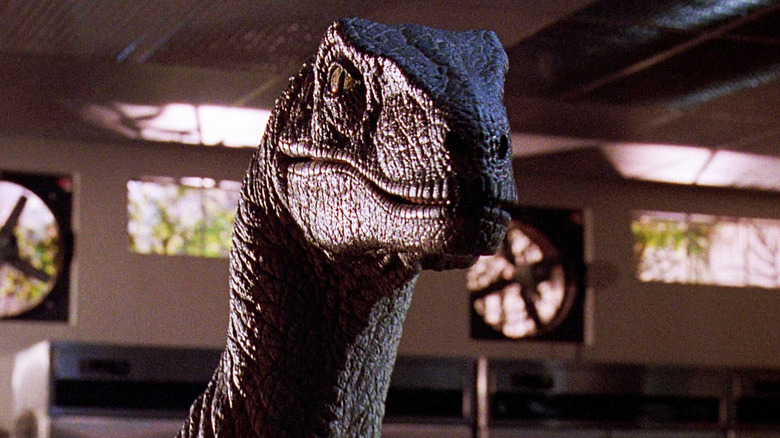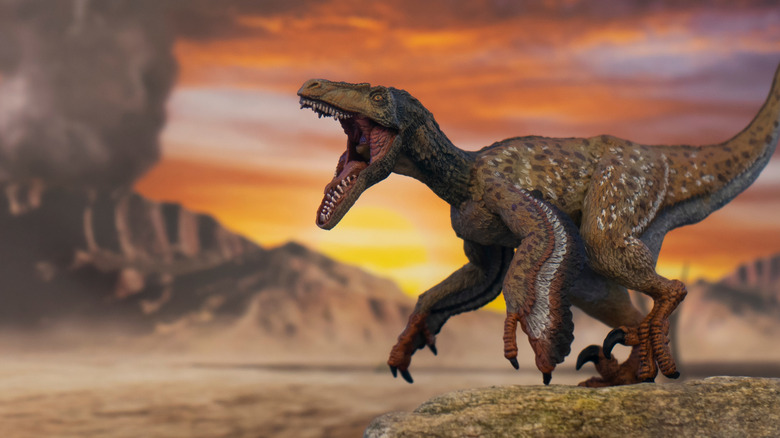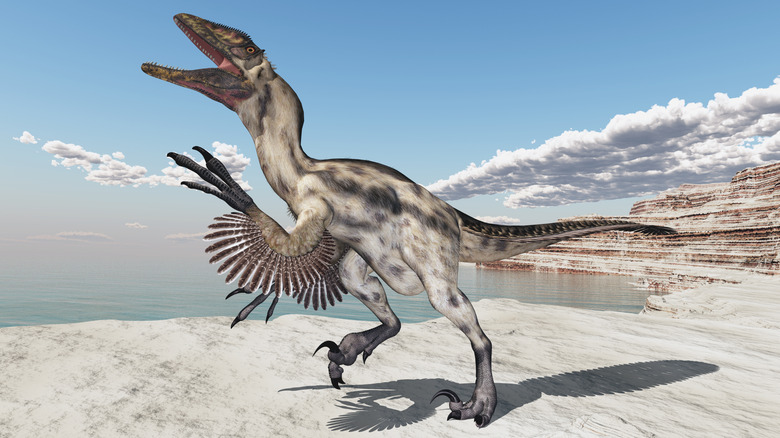Jurassic Park Lied To You About Velociraptors. Here's What They Really Looked Like
If you grew up with a love for dinosaurs a couple decades ago, you'll likely be surprised to find that many of these prehistoric beasts don't look the same today as you remember them. How can that be if they've been dead for around 66 million years? Well, because scientists are constantly discovering new fossils and facts about these ancient creatures, and our understanding of dinosaurs has evolved quite dramatically over the past few years.
For one thing, the Tyrannosaurus rex most 90s kids remember from Steven Spielberg's "Jurassic Park" is likely not the most accurate representation of the real-life carnivore. For one thing, T. rex are now believed to have sported patches of feathers, something that most certainly didn't appear on Spielberg's version of the predator. What's more, the real T. rex sounded a lot more terrifying than the version in "Jurassic Park."
But it turns out T. rex wasn't the most egregious departure from actual dinosaur anatomy in the 1993 blockbuster, which was an adaptation of Michael Crichton's 1990 novel of the same name. The film's other major predators, the Velociraptors, represented perhaps the most obvious embrace of creative liberty, as the creatures which terrorized Lex (Ariana Richards) and Tim Murphy (Joseph Mazzello) in the Jurassic Park cafeteria kitchen bore little resemblance to the raptors of the prehistoric era.
The raptors of Jurassic Park are nothing like the real thing
Dedicated "Jurassic Park" fans have debated whether the film was obliged to represent dinosaur anatomy accurately for decades. After all, the creatures in John Hammond's park were supposed to be hybrid dinos, who'd had the remnants of their amber-preserved genetic code filled in with DNA from frogs and other creatures. As such, it could be argued that the various dinosaurs in "Jurassic Park" were never meant to represent perfect examples of their long-extinct ancestors. Even with that in mind, there's no doubt that "Jurassic Park" helped shape an entire generation's perception of dinosaurs, and it turns out large parts of this perception were inaccurate.
In the film, the raptors depicted are large reptilian creatures, taller than humans with scaly skin and a vicious temperament. Indeed, real Velociraptors were carnivores who lived in the Late Cretaceous epoch 66 million years ago. But unlike the hefty beasts shown in "Jurassic Park," real raptors were comparatively diminutive. Though they weren't the smallest dinosaurs to ever exist, some sources say they did weigh just 100 pounds, and others claim they only reached sizes comparable to that of a large chicken or fox.
What's more, the raptors shown in "Jurassic Park" are missing the feathers which we now know real Velociraptors to have sported. In September 2007, a study published in the journal Science confirmed that Velociraptors had feathers. Paleontologists at the American Museum of Natural History and the Field Museum of Natural History examined a Velociraptor forearm unearthed in Mongolia in 1998 and, as noted in an AMNH blog post, there were "clear indications of quill knobs." The article in Science elaborates that these were places "where the quills of secondary feathers, the flight or wing feathers of modern birds, were anchored to the bone with ligaments." At that point, scientists knew that dinosaurs had feathers, but this was the first time such a feature had been confirmed in Velociraptors — just one example of the incredible things we can learn by studying fossils.
Why were the raptors in Jurassic Park so inaccurate?
It's not all that surprising that a Hollywood blockbuster might take some creative license in depicting its dinosaurs. But in the case of the Velociraptors, the differences between the movie version and the real life version are striking. Most of this comes down to the fact that neither original "Jurassic Park" author Michael Crichton nor Steven Spielberg based their raptors on actual Velociraptors. Rather, the comparatively hulking beasts of the book and movie were based on another species altogether: Deinonychus antirrhopus.
Both Velociraptors and Deinonychus belong to the group of small- to medium-sized carnivorous dinosaurs known as dromaeosaurs, but the latter were much larger, measuring 11 feet in length and weighing 220 pounds. The very first Deinonychus fossils were discovered in southern Montana in 1964, long after the first Velociraptor fossil was found in 1923. These specimens revealed Deinonychus' large sickle-shaped hunting claw on each of its feet, which can be seen on the "raptors" in "Jurassic Park."
Thus far it hasn't been proved that Deinonychus had feathers, but experts believe it's very likely they shared this feature in common with their Velociraptor cousins. So, while the creatures in Spielberg's film more closely resemble Deinonychus than Velociraptors, they are almost certainly inaccurate in their depiction of scaly skin rather than feathers. Interestingly enough, you can see what scientifically accurate Deinonychus would have looked like in "Jurassic Park" courtesy of YouTuber and VFX artist CoolioArt, who created 3D Deinonychus models and inserted them into footage from the film.


